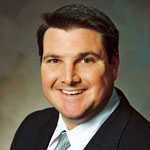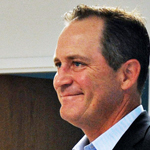
ThedaCare joined a statewide hospital network, promising to cut employers’ health-care costs by 10 percent. What are the areas or units that you make more cost-effective?
Greg Long: Patients with multiple medical conditions cost the most money to those that pay the health-care bills—specifically employers, insurance companies, and to some extent, the patients. So our plan is to be more aggressive when treating those complex, chronically ill patients. We are creating a model of care that includes, in addition to the primary care physician and nurse, other key clinicians like pharmacists, behaviorists, a nutritionist, and probably most importantly, a care coordinator.
Instead of the primary means of care being the doctor’s office visit, we are caring for these high-risk patients in nontraditional ways like e-care, home visits, and even patient-led group visits. If we are able to connect with and engage those patients, and understand what their barriers are, we are able to manage them much more effectively. That alone will have a dramatic impact on the cost of care. Although many systems in care delivery are striving for the same model, I am unaware of anyone that has put together the entire package of caregivers on a large scale.
There is heated competition between health-care providers in Wisconsin. Froedtert and Ministry recently announced plans to buy an insurer. Where do you see your advantages in the race?
Long: First of all, we don’t assume we know exactly what the patients want in their health-care experience, so we ask them and we listen, and then we design solutions with that information in mind. Once we know the patient preferences, we use a lean innovation method, led by an external expert, to help us create this new model of care. We want to be innovative and progressive to help us think beyond our usual paradigms and think differently about how we need to manage our patients. This new, complex patient-care model is nearly complete and will be rolled out to two of our clinic sites by the end of the year and to our remaining seventeen family medicine and internal medicine clinic sites by the end of 2016.
You once said, “For too long, medicine has revolved around physicians. We are moving toward a new model where medicine revolves around the patient.” Why is this shift necessary?
Long: Our health-care reimbursement system has always paid us to do things to our patients, the “fee-for-service” model. Over the years that model has created a mind-set, by clinicians and patients, that “more may be better.” Not to mention that, the more we do, the more profitable physicians and health systems will be. And for decades, the patient was insulated from those costs. We now know that model is unsustainable. The Centers for Medicare and Medicaid Services (CMS), other payers, and employers want to pay us differently in order to bring the cost of care under control—they want to pay for value, not volume. That’s a fundamental change. Our fully implemented team-based care model should dramatically reduce unnecessary health-care utilization, and in turn our revenue in the current fee-for-service model. Therefore, going forward we will need to get paid differently. We are depending on CMS, insurers, and employers to align a new payment method with our new care model.
What are the major demographic trends affecting your role as chief medical officer?
Long: Our aging population and worsening unhealthy lifestyle will continue to lead to a rising number of people with chronic health conditions, including diabetes, cardiovascular disease, and cancer. That combination is going to increase the stress on the health-care system and those who pay the health-care bills. Add the looming shortage of primary-care doctors and we are faced with the need to be more creative in managing these patients. I’m confident our comprehensive team-based care model, in addition to a new payment methodology, will fulfill that need.
How important is it to spend time with physicians to get to know their work?
Long: It’s critical that we have strong working relationships with all our physician partners, both independent and employed, so we can leverage their expertise, particularly in managing our complex, high-risk patients. The best way to build those relationships is to spend time with physicians understanding their work and their beliefs about what they think the future of health care will look like. There are varying opinions on how fast we are
really moving to this new value-based world. With uncertainty and ambiguity come fear and a strong desire to maintain the status quo. It takes time, patience, and a lot of dialogue to paint this new picture.
What has helped reduce the employed primary-care physician turnover rate to less than 1 percent?
Long: From 2004–2005, we spent fifteen months with the senior leadership team and our primary care doctors to create the TCP Physician–ThedaCare Compact. We had conversations with more than 90 percent of our primary-care doctors, who helped us develop that compact. At its core, it’s a clearly articulated set of mutual expectations between the organization’s leadership and the employed providers, which primarily revolves around decision making. We engage our physicians in decisions we think will have an impact on them. Prior to the compact and in the early years, our turnover rate was 6–7 percent. For the last three years, it has been less than 1 percent.

